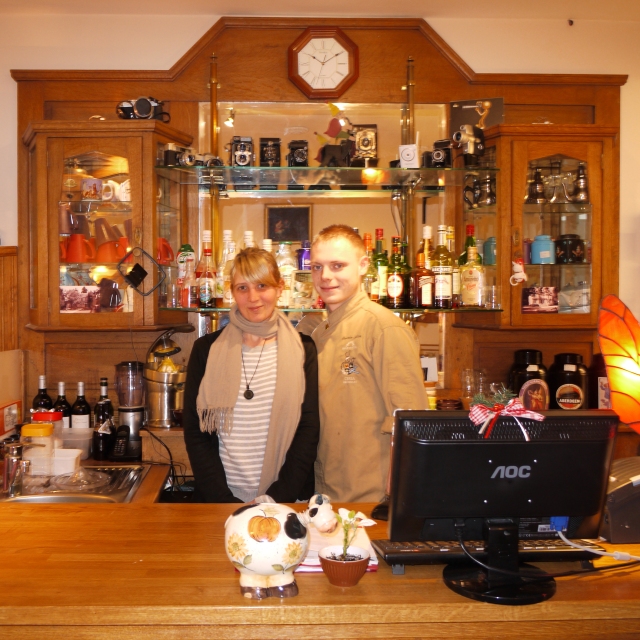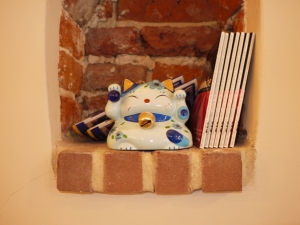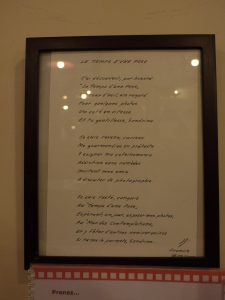The day started really early, as I promised to visit “droguerie” Le Lion again, and to meet the mother of Frederic and Renaud, Anne-Marie. So I got up at 6.30 am (it’s still dark, you know?) to arrive in Brussels at 8am, where I was in time to meet Mother Billiet, together with her two sons.
The mother tells me the store is like “La caverne d’Ali Baba”, Ali Babas cave, because shopping here is a bit like treasure hunting. What I didn’t know yet is that all the drawers behind the counter still contain the products that are indicated. But lately they are getting problems with the government for some of them, as they could be used for creating drugs and bombs. So know they need a lot of permits to be able to sell the same produts as they’ve been doing for years without a problem. So terrorists with a serious drug addiction, know where to go now! It’s all there…
In 1946 when the father of Anne-Marie, Paul Billiet, took over the store, there were 311 (real) drugstores in the region of Brussels, now there’s only one left, Le Lion. Their “Cheval de Bataille” or cockhorse are the pigments, for which they come from all over the country.
After this meeting I needed a coffee, because I didn’t had the time before. I went to a café called “Le temps d’une pose“.
Where I was welcomed most friendly by Sandrine Conte, who is a girl from Paris who came to live in Brussels 14 years ago and who started this café 1,5 years ago. On the picture you can see her next to her chef-cook.
The café used to have the name “Zageman”, before she bought the house and redecorated it. I read on the internet it used to be a real “brown” bar.
The name of the bar “Le Temps d’une Pose”, comes from “le pose photo” or a picture pose. In the end of the bar there is a wall where photographers can show their work for two months, free of charges and commissions. Right now, the work of Myriam Dierickx can be seen.
Sandrine introduced me as well to two of her customers who told me a little of the history of Brussels. Although it was interesting, it was not really specific about the rue de Laeken, and therefore not really usefull for my project. But they gave me some adresses close to the rue de Laeken, where I could go to meet some of the real Bruxellois-people. Those who still use the words “tischken” and “skieve lavaboo”.
Some pictures from the bar:
One of the customers promised me to get a book from the library about the history of the streets of Brussels. Her name is Betty Henman, again a very nice person. I met her again today in the street while I was visiting the butchery, the florist and the paint-store.
Betty told me to speak Dutch when visiting the butcher, he was going to like this. So I did when I arrived there, but the woman who was there, wasn’t interested in the project.
She prefered not to be bothered with questions about the street or whatever, because she had problems enough. As I was a bit surprised with her reply I asked about the specific problems and she pointed to a bar on the other side of the street. “In the evening, and at night”, she said, “it’s always full of noise. And there are people fighting in the street, even this morning. You should come and stay here for a night, terrible! All because of these damn prostitutes in the street.” Right, I forget to tell you about them… I was planning to integrate them in the project in a way, but I’m still looking for the right one. The woman did tell me there was a guy who wrote his thesis (or something) about the street, and she was going to get me a copy of this tomorrow.
My next stop was florist Jettie, with a beautiful vitrine full of plants and flowers.
The manager, mister de Mooij, tells me it is a family business that exists for over 70 years. Originaly the Mooij family comes from Holland, but moved to Belgium to start a flower shop in Brussels. On the picture you see him with two of his employees.
He used to work with his two brothers, but they both quit the business to do something else. It used to be a smaller store somewhere else in the street, but they moved it and got a lot bigger. He tells me that when his father worked there the street was much more vivacious than it is today. There used to be a lot of nice bars, and the street was like a family, everyone knew eachother. Nowadays there isn’t that much of passage anymore in the street, except during the night when the tootsies are coming out. So most of his customers order by phone or email. He says it is improving again, but that it is going to take some time.
As I ask him more about the history of the store, he digs three pictures up from his basement. The first one is the founder of the business, together with his favorite horse. The second one is a family portrait with his parents and two of his brothers and the last one is a picture of a car that crashed the vitrine. He told me during that year, three cars drove into their business, one a police van…
He also told me he remembered the Lakensestraat from the Monopoly game, as it was one of the streets you could buy in the game (one of the three ‘yellow’ streets).
Some flower/logo pics:
At the end of my tour today, I visited De Keyn, specialized in paint.
I met Raymond Lascience. But what I asked him is top-secret and will only be reveiled on the 25th of February…
Et maintenant TRUCTROC!


























